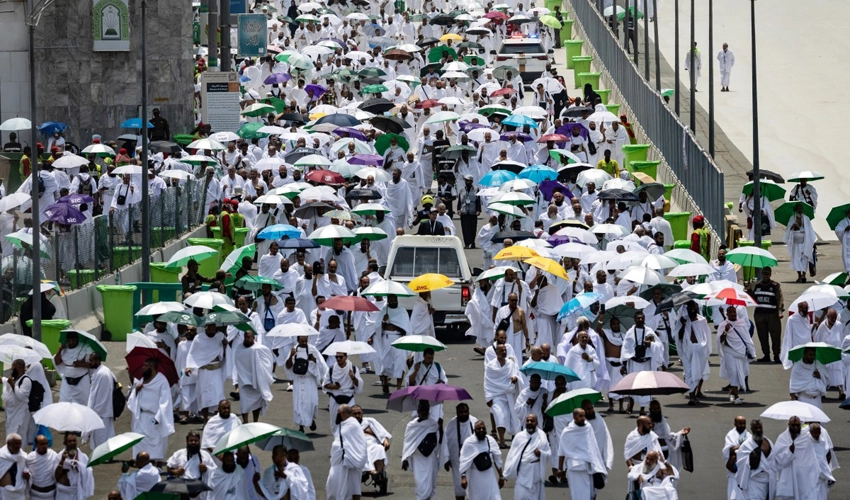Hajj 2024: 2.5 million pilgrims begin sacred journey for forgiveness and blessings of Allah Almighty

MAKKAH (APP) - As the curtain rises on Hajj 2024, the tranquil valley of Mina braces itself for an influx of 2.5 million devout pilgrims, including 160,000 Pakistanis, converged from all corners of the globe to embark on a spiritual journey today that culminates in the sacred celebration of Eidul Azha.
For nearly a month, faithful pilgrims have gathered in Makkah, the land revered as ‘Umm al-Qura’ (Mother of All Settlements) – the epitome of Divine planning – to engage in a profound communion with the Creator, beseeching His forgiveness for their transgressions and invoking blessings upon their souls.
According to official reports, over 1.5 million pilgrims have already arrived in Saudi Arabia in anticipation of the Hajj, with more expected to join them, swelling the ranks alongside hundreds of thousands of Saudis and residents of the kingdom as the pilgrimage officially commences on Friday.
This year’s pilgrimage is poised to surpass the numbers of 2023, where over 1.8 million faithful had fulfilled their Hajj obligation.
Pakistan has meticulously orchestrated arrangements to shepherd its Hajj pilgrims (Hujjaj) through every facet of their journey, from the moment they set foot in Madinah and Makkah. From airport reception to transportation, accommodation, nourishment, medical care, guidance by Moavineen (guides), and onwards to the sacred sites (Mashahir) and back to their homeland, every detail has been carefully attended to.
The pilgrimage commences with the solemn act of entering Ihram – a sacred state for pilgrims – upon crossing the outer boundaries of Makkah known as Miqat, marking the commencement of an eight-kilometer journey.
On the eve of the 7th and 8th of Zilhaj, pilgrims embark on their pilgrimage to Mina, spanning a distance of 8.1 kilometers, utilizing various modes of transportation including trains, buses, and foot, as they settle into the tent-city.
The 8th of Zil-Hijjah, known as Tarwiyyah Day, finds pilgrims immersed in prayer and reflection in the tranquil precincts of Mina, preparing their hearts for the spiritual ascent that lies ahead.
At dawn on the 9th of Zilhaj, pilgrims, embark on the pivotal leg of their journey, proceeding to the plains of Arafat to partake in collective prayers and supplications, punctuated by a sermon delivered from Masjid al-Nimra on Mount Arafat.
The day of Arafah holds profound significance, hailed in Surah al-Maidah as the day Allah perfected His religion, sealed His favours upon Holy Hazrat Prophet Muhammad (Peace Be Upon Him), and ratified Islam as the ultimate way of life.
As the sun sets, pilgrims depart Arafat for Muzdalifah, where they engage in Maghrib and Isha prayers, abbreviated to two rakats each, before collecting pebbles for the ritual of Rami over the ensuing days.
The 10th of Zilhaj, the Day of Sacrifice (Yawm al-Nahr), witnesses pilgrims’ return to Mina from Muzdalifah, offering sacrifices, commencing the Rami ritual, and proclaiming the commencement of Eidul Azha festivities worldwide.
Over the next three days, pilgrims continue the Rami ritual, casting seven pebbles on the first day and 21 on each subsequent day, alongside trimming or shaving their hair, symbolizing spiritual renewal and rebirth.
On the 12th of Zilhaj, the climax of the Hajj journey unfolds as pilgrims embark on a sacred pilgrimage to Makkah to fulfill the rites of Tawaf al-Ifadah and Sa’ai of Safa and Marwah. These rituals, integral to the Hajj experience, follow the completion of key acts such as the symbolic stoning of the devil, the offering of sacrifices, and the trimming of hair.
With the culmination of Tawaf and Sa’ai, pilgrims find a moment of respite, allowing them to engage in activities permissible before their consecrated state of Ihram. Yet, their hearts remain tethered to the sanctity of their pilgrimage, prompting them to return to their tents in Mina to fulfill the remaining obligations of Hajj.
Prior to their departure from Makkah, pilgrims undertake the poignant ritual of the farewell Tawaf, marking the culmination of their spiritual journey. This solemn act entails completing seven laps around the Kaaba, offering two ‘rakats’ of Salah, and quenching their thirst with the blessed waters of Zamzam. Unlike previous Tawaf rituals, no Sa’ai or hair trimming is required after this final circumambulation, symbolizing the conclusion of their sacred pilgrimage.







